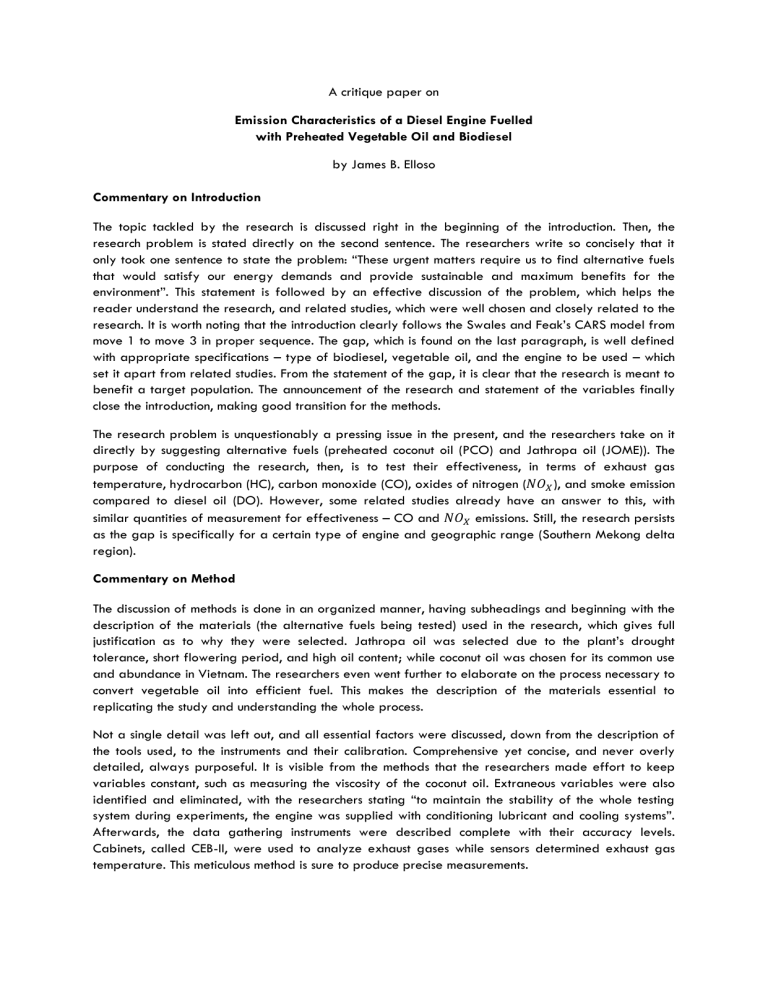
A critique paper on Emission Characteristics of a Diesel Engine Fuelled with Preheated Vegetable Oil and Biodiesel by James B. Elloso Commentary on Introduction The topic tackled by the research is discussed right in the beginning of the introduction. Then, the research problem is stated directly on the second sentence. The researchers write so concisely that it only took one sentence to state the problem: “These urgent matters require us to find alternative fuels that would satisfy our energy demands and provide sustainable and maximum benefits for the environment”. This statement is followed by an effective discussion of the problem, which helps the reader understand the research, and related studies, which were well chosen and closely related to the research. It is worth noting that the introduction clearly follows the Swales and Feak’s CARS model from move 1 to move 3 in proper sequence. The gap, which is found on the last paragraph, is well defined with appropriate specifications – type of biodiesel, vegetable oil, and the engine to be used – which set it apart from related studies. From the statement of the gap, it is clear that the research is meant to benefit a target population. The announcement of the research and statement of the variables finally close the introduction, making good transition for the methods. The research problem is unquestionably a pressing issue in the present, and the researchers take on it directly by suggesting alternative fuels (preheated coconut oil (PCO) and Jathropa oil (JOME)). The purpose of conducting the research, then, is to test their effectiveness, in terms of exhaust gas temperature, hydrocarbon (HC), carbon monoxide (CO), oxides of nitrogen (𝑁𝑂𝑋 ), and smoke emission compared to diesel oil (DO). However, some related studies already have an answer to this, with similar quantities of measurement for effectiveness – CO and 𝑁𝑂𝑋 emissions. Still, the research persists as the gap is specifically for a certain type of engine and geographic range (Southern Mekong delta region). Commentary on Method The discussion of methods is done in an organized manner, having subheadings and beginning with the description of the materials (the alternative fuels being tested) used in the research, which gives full justification as to why they were selected. Jathropa oil was selected due to the plant’s drought tolerance, short flowering period, and high oil content; while coconut oil was chosen for its common use and abundance in Vietnam. The researchers even went further to elaborate on the process necessary to convert vegetable oil into efficient fuel. This makes the description of the materials essential to replicating the study and understanding the whole process. Not a single detail was left out, and all essential factors were discussed, down from the description of the tools used, to the instruments and their calibration. Comprehensive yet concise, and never overly detailed, always purposeful. It is visible from the methods that the researchers made effort to keep variables constant, such as measuring the viscosity of the coconut oil. Extraneous variables were also identified and eliminated, with the researchers stating “to maintain the stability of the whole testing system during experiments, the engine was supplied with conditioning lubricant and cooling systems”. Afterwards, the data gathering instruments were described complete with their accuracy levels. Cabinets, called CEB-II, were used to analyze exhaust gases while sensors determined exhaust gas temperature. This meticulous method is sure to produce precise measurements. What is not discussed, however, is the statistical methods used in the research. This may be easily overlooked, but it raises question on how the measurements were treated, therefore compromising the reliability of the results. Commentary on Results and Discussion Results of the experiment are presented in neat line graphs with consistent color coding and legends. These graphs help the reader to visualize and digest the results with ease. It is evident that the researchers followed the data commentary format in their presentation – the locating statements, highlighting statements and discussions are easily identified. Previous studies were cited and possible explanations were provided to back up the data. However, the multifactorial analysis of data (different PCO temperatures and types of alternative fuel) makes it difficult to follow the discussion. This could not been avoided as the different factors were being compared to one another; multifactorial analysis was necessary. As for the content of the results and discussion, the factors being studied (exhaust gas temperature, HC, CO, 𝑁𝑂𝑋 , and smoke emission) were not defined explicitly, and so, the readers are left to search for meaning on their own. The researchers also focused on explaining the reasons behind each result that implications and significance of the findings were not thoroughly discussed. What is the significance of the JOME having the highest exhaust gas temperature and 𝑁𝑂𝑋 emission, and lowest HC, CO and smoke emissions? What is the implication of the PCO having lower exhaust gas temperature than DO? Neither does the conclusion provide answers to such questions. The conclusion only the states that the “fuel properties of JOME and PCO_t100 satisfy the fuel requirements for diesel engines,” which is the research’s main finding. The lack of discussion on the implications and significance render the results of the experiment rather futile. Still, the objective was reached and the finding provides an answer to the research problem – that JOME and PCO may serve as alternative fuels. Epilogue This research finds its significance in proving the viability of Preheated Coconut Oil and Jathropa Oil Methyl Ester as alternative fuels for a D243 diesel engine. It is a product of a meticulous methodology and tedious experiment. With the researchers having stated that the engine may be installed in small ships/boats or on agricultural fields in Vietnam’s Southern Mekong Delta region, I long to see the finding of this research applied in real life, and the fuels used by the people for whom this research was conducted. In light of the continuity of all research, it is recommend that future studies use a statistical treatment to compare the efficiency of alternative fuels and diesel, as well as delve on the environmental effects of harvesting coconuts and Jathropa, as well as the processes involved to further prove the practicality of using them as alternatives.


